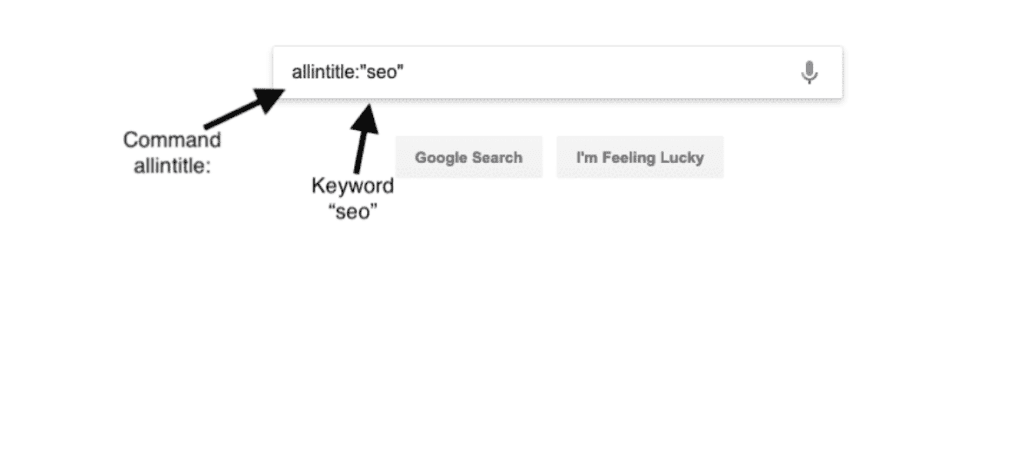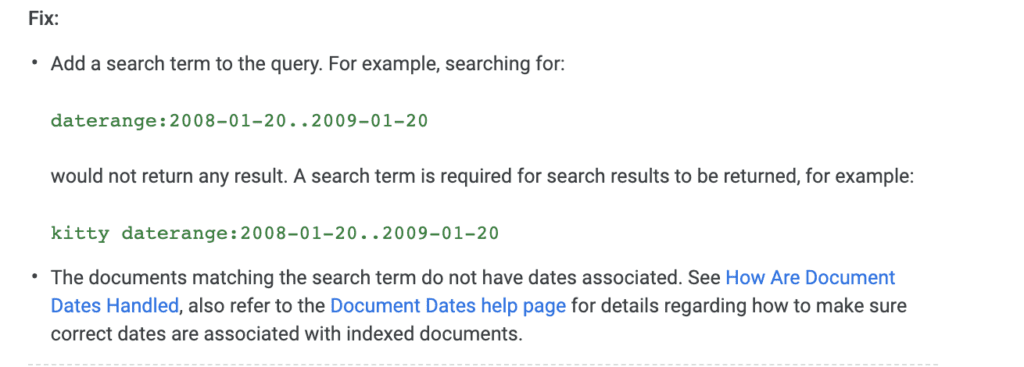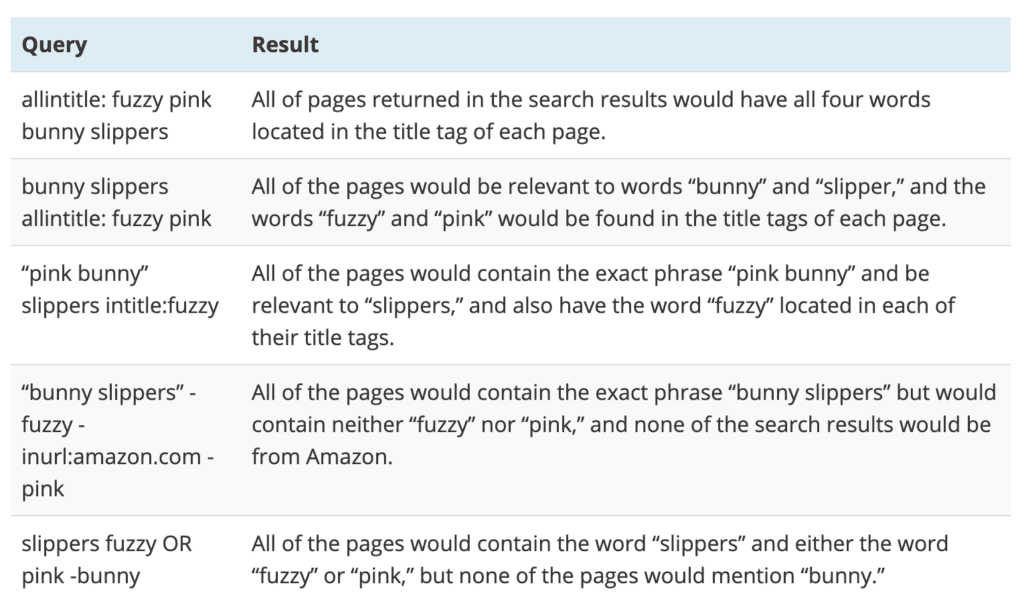You’re probably familiar with the basic setup of Google search. You enter a few words or a question into the search bar, and the algorithm serves up the most relevant sources based on several ranking factors.
Google search operators allow you to get real granular with your internet research.
In this post, I’ll explain exactly what Google search operators are and go through a list of search commands.
I’ll also offer some specific examples of how you might use search operators to level up everything from site audits to content research, backlink opportunities, and more.

What are Google Search Operators?
What are Google Search Operators?
Google search operators are special characters and commands designed to help you filter and refine the search engine results that appear when you enter a search query.
Searchers can use this set of commands to perform in-depth research directly from the search bar like they’ve done in this example below:

Example of a Google search operator Source
Quotes (“”)
Quotes are used to make sure that the results you receive contain your target search term in the correct order.
To enable Quotes, enter quotation marks around your target query.
For example, if I search for “dog training classes,” all of the results that turn up include “dog training classes.”
This search operator is best used when your query contains individual words with high search volume. For example, “chocolate desserts” can help you find examples of chocolate desserts, rather than pull up top results that include both “chocolate” and “desserts” in any order.
OR
The “OR” command can be used when you want to return results that have one search term or another. The idea is, you’re essentially combining the two search results into one.
For example, if you’re looking at a few options for your next vacation, you might enter “flights to Hawaii” OR “flights to Italy” to compare prices to help narrow your decision.
site:
Let’s say you type in site:www.ignitevisbility.com; Google will serve up every URL on this domain. This command works well when used with other search operators like quotes.
For example, entering site:wired.com “Apple” would allow me to search through anything Wired has published about Apple.
intitle: and allintitle:
The search operator intitle: will return items with at least one of the search terms in the title. For example, intitle: “SEO strategies” “guest posting” might include posts containing “SEO strategies” in the title, that mention “guest posting” somewhere in the body, or vice versa.
If you’d rather locate a post that focuses on SEO strategies related to guest posting, “allintitle:” might be a better bet, as both search terms will be included in the title.
AROUND
inanchor: and allinanchor:
Similar to the intitle/allintitle: commands, inanchor: and allinanchor: operators will return results that target specific search terms within a page’s anchor text.
So, looking at something like allinanchor: “photography apps,” Google will show several pages feature anchor text with the keyword “photography apps.”
While this search directive may seem hyper-specific at first blush, it’s actually a great tool for link-building.
inurl: and allinurl:
inurl: and allinurl: work much like the allinanchor and intitle search operators mentioned in the previous two sections. In this case, you’re telling Google to show only results where one or all of your target keywords are included in the URL.
Exclusions
Google is famous for giving you a whole lot of search results that you don’t necessarily need.
Exclusions as an antidote to the situation, allowing you to exclude certain items from your search results. This search operator works especially well when you’re searching for information containing a keyword with multiple meanings.
In this example below, the searcher is looking for information about Google search that doesn’t include search operators or reference Google Search Console experts. Since Google-related content covers this huge expanse of topics from the SERPs to the GSC, Google My Business, and the ever-changing algorithms, excluding specific topics can help you find the information you need–ASAP.

Excluding specific topics can help you find the information you need–ASAP (Source)
Related
According to Google, you can put “related:” in front of a URL to identify more sites like it.
So, let’s say I enter the query, “related:forbes.com.” In this case, Google shows me a list of similar websites, such as Bloomberg, The Motley Fool, and Inc.
Related: is great for content discovery–i.e., if you like Forbes, Google can help you find other sites that cover the latest business news. For marketers, related: presents another tool for market research. You might type in your own site to identify new competitors, check the pulse of existing ones, and look at products, services, prices, and content.
Wildcard (*)
The wildcard operator can be used to locate information when you’re working with an incomplete query.
However, the wildcard doesn’t provide the most accurate SERP results, as it doesn’t we’ve doesn’t look for specific keywords within the text. Consider it a way to narrow your search criteria as you dig for particular information.
For example, you might use it to locate a specific category page or section on a website.
You might also stack this search operator with other commands. For instance, you could use “site:” operator” with “wildcard to search within the Ignite Visibility blog: site:https://ignitevisbility/blog*.
This way, you don’t need to sift through the homepage or services, and instead can start combing through the blog content until you find what you need.
cache:
Using cache: allows you to search for the cached version of any website.
For example, cache:ignitevisibility.com redirects to webcache.googleusercontent.com and displays the version of our homepage Google has stored.
This is a quick way to check whether Google has implemented any updates you’ve made to your site, and can tip you off to any potential errors preventing the new version from being indexed.
source:
This Google search operator allows you to search for Google News articles coming from a single source–namely those that appear in the Top Stories snippet. If I enter “source: search engine journal,” SEJ rules the snippets and has the top two text-based results.

A Google search for “SEJ” brings up featured snippets
It’s worth noting that some of the first page results aren’t from the website itself, but Wikipedia and sites that link to SEJ like Search Engine Roundtable and Search Engine Watch.
That said, the results stay on topic and come from related sites–so someone looking for SEO tips might find these other results useful. For those looking for results specific to one site, you might instead look toward the “site:” search operator.
Search Within a Range of Numbers
Google also allows you to specify a range of values within your search query by separating two numbers with two periods.
For example, you can enter something like “women’s ankle boots 150..300” to find a new pair of boots that match your budget.
This tool is relevant for shoppers looking for everything from clothing and housewares to electronics, allowing them to comparison shop with slightly less effort.
That said, the search operator may also be useful for marketers looking to perform competitive research. Are similar brands pricing products in the same price range as your site? If not, what’s unique about your product, and how might that impact the price?
Filetype:
Filetype searches allow you to hunt for a specific file type such as .PDF, .jpg, .png, or .gif. The benefit here is, searchers can find images, infographics, or whitepapers to reference in your blog content.
Additionally, it can also help you identify your own assets such as images, GIFs, and infographics that have been picked up by Google.
Search within a date range
Google’s daterange: operator can help you refine your search results in a more granular way than the “tools” found next to the search box. Instead, you can use daterange: to say, find content published between 2017 and 2019 or during the first half of 2019.
I should mention, however, the daterange: search operator does come with sort of a strange caveat–you’ll need to format dates according to the Julian calendar format as opposed to the Gregorian model most of us are used to.
Here’s how that might look:

daterange: Google search operator example (Source)
Find Content from Individual Authors
Using the operator allinpostauthor: allows searchers to find content written by top thought leaders and influencers in your field. You might use this to link to credible experts on a particular topic, find valuable research information, or build these mentions into a larger link-building strategy.
How to Use Google Search Operators in the Real World
While many of the search operators outlined above are relatively straightforward, applying them toward a specific objective is a bit more challenging.
Practical E-commerce’s Jill Kocher Brown offers up some examples of how you might layer various advanced search operators on top of one another to deliver more granular results:

How to layer advanced search operators to deliver results (Source)
Below I’ve included some search operator use cases you can work into your existing SEO strategies.
Dig Deeper Into Website Content Research
Many of the search operators I’ve mentioned can help you perform targeted research to better understand the competitive landscape as it plays out in the SERPs.
That said, if we’re specifically talking about content, Google search operators are an effective tool for identifying which approaches to a particular topic are likely to yield the best results.
So, if I’m thinking of creating a big roundup of video marketing tactics, I might search for “video marketing tips” to see what other people have written on the subject.
Based on my findings I might:
Focus on creating a more creative title and meta description to capture audience attention.
ID strategies not covered in the top posts.
Follow a list post format, as “tips” posts tend to signal to readers that they’re getting a list of things to implement into their strategy.
You might also look for you know who wrote an article you’re looking for, you can use the allinpostauthor: “video marketing” to see if a particular influencer has covered this idea and how they approached it.
Identify Stolen Content
As your content begins to develop a following, copycats might start to take notice.
While Google has gotten better at detecting plagiarized content, low-quality sites still scrape and republish content on the regular. Which, fair or not, could open up the risk of duplicate content issues on your end.
Search for dupes by grabbing an excerpt from your content and search for it by pasting it inside quotations. The Google results will then display all instances of those words in that exact order–and if they don’t point back to your website, offer a list of sites to report.
Look for Guest Posting or Podcasting Opportunities
I’ve talked about guest posting quite a bit lately. It’s one of the best ways to boost your off-site SEO performance, grow your reputation, and attract more qualified traffic to your site.
However, looking for guest posting opportunities can be a time-consuming game of trial and error with some websites actively seeking help filling up their content calendars while others don’t accept guests.
You might start your search with: “[keyword]” “write for us,” or “[keyword]” inurl:blog “contributor guidelines,” “[keyword]” inurl:blog “write for,” to narrow your options to niche-specific sites that welcome guest contributors.
Additionally, podcasting is a great way to spread your expertise across another channel. The approach is similar to guest posting opportunities, though most podcasters use Stitcher or Apple Podcasts to distribute their episodes. As such you might use operators as follows to ID potential guest slots:
site:stitcher.com intitle:”[keyword]” “guest host”
site:stitcher.com inurl:[keyword] “guest”
site:podcasts.apple.com intitle:[keyword]
Find Unsecured Content
As you may have heard, Google has made “https” a ranking factor, in part to motivate site owners to make the migration from “http.” While most website owners have done this, sometimes a page or two can slip through the cracks and undermine your search rankings.
Another common problem associated with migrations is, sites may end up delivering unsecured pages to Google and human visitors alike.
You can search for unsecured pages by using the following advanced search operators: site:, inurl, and minus operators.
If you want to check, say, Time’s website for unsecured content you’ll enter: “site:time.com -inurl:https.” As you can see below, the search results reveal a handful of unrelated, outdated articles that somehow didn’t migrate with the rest of the group.
Wrapping Up
The benefit of embracing Google search operators is clear: they’re a fast and easy way to streamline your research process, and it doesn’t cost anything to use them.
However, they’re not exactly obvious and you need to be in the know to take advantage of them. Hopefully, the examples I’ve outlined above help make the process a bit more approachable, as getting to know these commands can open up a new world where the right information is always at your fingertips and competitive intel is just a “keyword” and : away.